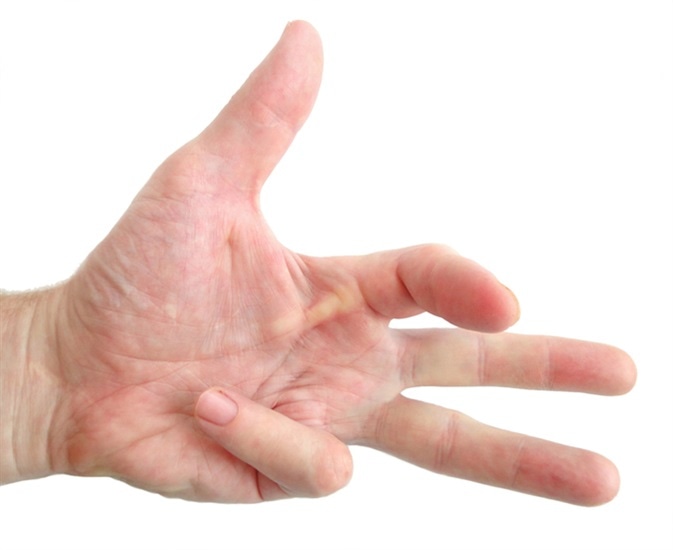Dupuytren’s disease (also known as Dupuytren’s contracture) is a benign condition of the skin characterized by the overgrowth of myofibroblasts. The reasons for this type of proliferation are unknown as yet, though several conditions have been postulated to be associated with increased risk of developing this condition.
The superficial fibromatosis results in the formation of nodules and cordlike structures just below the skin. This leads to the incurling of the fingers, starting with the ring and little fingers.

Hand of an man with contracture Dupuytren. Image Credit: Sokolenok / Shutterstock
Epidemiology
Dupuytren’s contracture is more frequent in certain regions of the world, and among some races. It is thought to be due to a genetic predisposition which was brought into Europe by the Viking invaders many centuries ago.
The condition is most prevalent in the northern European races, and among Caucasians. Its occurrence is higher among males. The age group in which its prevalence is highest is above 50 years in males and above 60 years in females.
Etiology
It is supposed that certain genes undergo mutation which leads to their dysregulation, as a result of which fibroblast growth is affected within the palmar aponeurosis. This leads to their differentiation into mature myofibroblasts which secrete an excess of type III collagen fibers.
Furthermore, Dupuytren’s disease is reported to be familial, which supports the genetic factors in its etiology. The presence of the gene is unlikely to be sufficient to precipitate the condition; instead, it is perhaps activated by other co-existing conditions such as diabetes mellitus or smoking.
Risk Factors
Risk factors for this condition include:
- Having a parent with Dupuytren’s contracture
- Trauma to the hand
- Doing manual labor or experiencing prolonged mechanical vibration to the hands
- Smoking
- Anticonvulsants from certain categories
- Seizure disorders
- Alcoholism
- Liver disease
- Diabetes mellitus
Natural History
Dupuytren’s contracture begins with a focal nodular thickening in one area of the palmar aponeurosis, less than one centimetre in size at first. It may be tender initially, but this does not last long.
This is followed by the development of more nodules, which eventually join up to form a cord of fibrous tissue which contracts by its nature, tethering the fingers to which it is attached and pulling them inwards towards the palm. This contracture worsens inexorably until the hand is often disabled.
Dupuytren’s Contracture and Malignancy
The myofibroblasts in this condition display many common characteristics with those of malignancy, which may be summarized as follows:
- Infiltrative growth
- Proliferative tendency
- Inhibition of apoptosis
- Strong predilection towards recurrence
- Molecular resemblances to solid tumor cells such as similar number of chromosomal abnormalities and receptors for monoclonal antibodies to human sarcoma cells, with underexpression of tumor suppressor genes such as p53
However, the contracture is not a risk factor for the development of cancer within the fibrosed area. An exploratory study has also shown that it is not associated with a higher risk of common malignancies such as breast or prostate carcinoma, lung cancer, and colon cancer.
However, male relatives of patients with this condition do have a slightly more than expected incidence of tumors of the central nervous system and larynx. Female relatives actually have a somewhat lower incidence of skin cancers other than melanoma.
References
Further Reading